The melodramatic romance and World War I epic The Big Parade (1925) is one of MGM's all-time biggest hits and one of the classics of the silent film era. John Gilbert plays a young American soldier, who witnesses the horrors of 'the Great War'. Renée Adorée and Karl Dane co-starred and King Vidor was the director. The film stills were made by Ruth Harriet Louise.
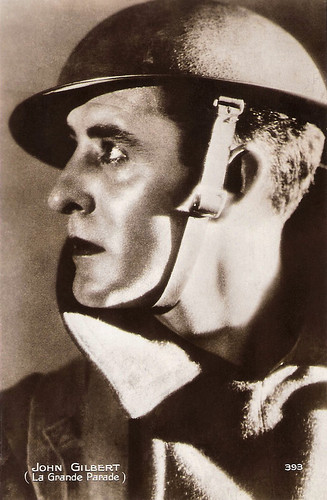
John Gilbert. French postcard by Editions Cinémagazine, no. 393. Photo: Ruth Harriet Louise / MGM. Publicity still for The Big Parade (King Vidor, 1925). Ruth Harriet Louise (1903-1940) was the first woman photographer active in Hollywood. She ran Metro-Goldwyn-Mayer's portrait studio from 1925 to 1930. She was the uncredited still photographer for The Big Parade.
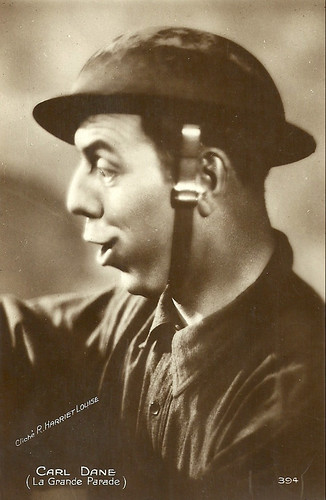
Karl Dane. French postcard by Editions Cinémagazine, no. 394. Photo: Ruth Harriet Louise / MGM. Publicity still for The Big Parade (King Vidor, 1925), starring John Gilbert. The French title of the film was La Grande Parade. Karl Dane was sometimes spelled as Carl Dane.
After director King Vidor complained to MGM production chief Irving Thalberg that he was tired of shooting pictures that played in theatres for just one week, he told Thalberg about a new kind of realistic war film he had envisioned. Thalberg was enthusiastic about Vidor's vision, and tried to buy the rights to the hit Broadway play What Price Glory? co-written by Maxwell Anderson and World War I Marine veteran Laurence Stallings. Since the rights to the popular anti-war play had already been acquired, Thalberg hired Stallings to come to Hollywood and write a screenplay for the new, realistic war picture that Vidor had dreamed about making. Stallings came up with The Big Parade, an anti-war story that dispensed with traditional concepts of heroism, focusing instead on a love story between a Yank soldier and a French girl.
The Big Parade (1925) takes place from April 1917 to the Spring of 1919. John Gilbert plays Jim, the idle son of a rich businessman, who joins the US Army's Rainbow Division when the U.S.A. enters World War One. He is sent to France, where he becomes friends with two working-class soldiers, Southern construction worker Slim (Karl Dane) and Bronx bartender Bull (Tom O'Brien). He also falls in love with the French girl Mélisande (Renée Adorée), despite not being able to speak each other's language. He has to leave her to move to the frontline. There, he experiences the horrors of trench warfare in a battle that was based on the WWI Battle of Belleau Wood, which raged for most of the month of June 1918. US forces suffered nearly 10,000 casualties, including 1800 killed. Author Laurence Stallings served as a Marine Captain and lost a leg in this battle.
One of the most famous scenes of The Big Parade (1925) is the romantic scene in which Jim (John Gilbert) teaches Melisande (Renée Adorée) to chew gum. The scene was improvised on the spot during filming. Director King Vidor observed a crew member chewing gum and later recalled, "Here was my inspiration. French girls didn't chew or understand gum; American doughboys did...Gilbert's efforts to explain would endear him to her and she would kiss him...[It was] one of the best love scenes I ever directed." Gilbert also claimed that neither he nor Vidor expected Adorée to swallow the gum, which proved to be the scene's comic highlight.
After Vidor completed principal photography, Irving Thalberg took the rough cut and previewed it before live audiences in Colorado. The audiences responded favourably, and Thalberg decided to expand the scope of the picture, as Vidor had created a war picture without many scenes of war. He had Vidor restage the famous marching army column sequence with 3000 extras, 200 trucks, and 100 airplanes. After Vidor moved on to another project, Thalberg had other battle scenes shot by director George W. Hill.
The result was a huge box office hit. The Big Parade (1925) played at New York's Astor Theater for two years and at that one theatre alone grossed $1.5 million during that time - more than three times its production cost of $245,000. Today. it is the highest-grossing silent film of all time, making $22 million during its worldwide release. The Big Parade is one of the first films that neither glorified the war nor ignored its human costs. It heavily influenced many subsequent war films, especially All Quiet on the Western Front (Lewis Milestone, 1930). The film boosted John Gilbert's career and made Renée Adorée a major star, although Adorée would soon be diagnosed with tuberculosis and die only a few years later, 35 years old.
When MGM discovered that a clause in director King Vidor's contract entitled him to 20% of the net profits, studio lawyers called a meeting with him. At the meeting, MGM accountants played up the costs of the picture while downgrading the studio forecast of its potential success. Vidor was persuaded to sell his stake in the film for a small sum. The film ran for 96 weeks at the Astor Theater and grossed $5 million (approximately $50 million in 2003 dollars) domestically by 1930, making it the most profitable release in MGM history at that point. Vidor later said, "I thus spared myself from becoming a millionaire instead of a struggling young director trying to do something interesting and better with a camera."
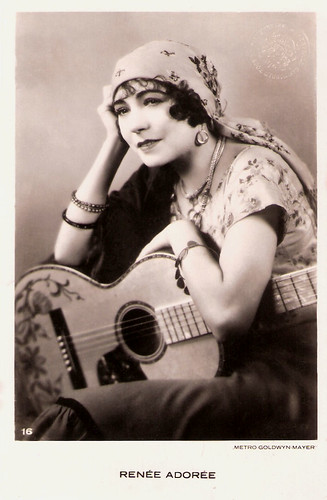
Renée Adorée. Dutch postcard, no. 16. Photo: Ruth Harriet Louise / Metro-Goldwyn-Mayer. Publicity still of The Big Parade (King Vidor, 1925).
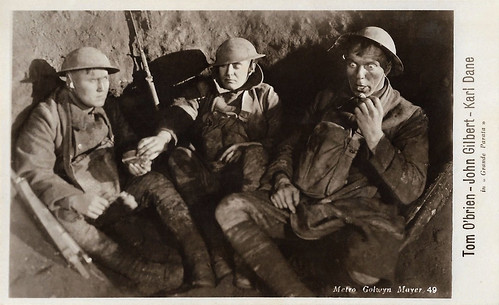
Tom O'Brien, John Gilbert, and Karl Dane. Italian postcard by G.B. Falci, Milano, no. 49. Photo: Ruth Harriet Louise / Metro-Goldwyn-Mayer. Publicity still for The Big Parade (King Vidor, 1925), released in Italy as Grande Parata/La grande parata.
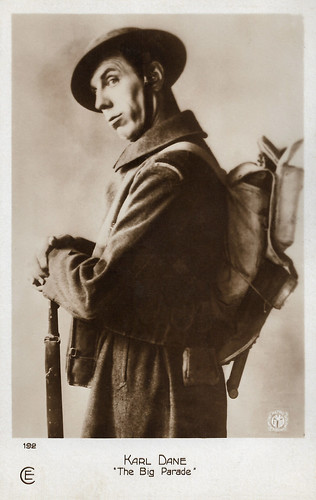
Karl Dane. French postcard by Editions Cinémagazine, no. 192. Photo: Ruth Harriet Louise / Gaumont-Metro-Goldwyn. Publicity still for The Big Parade (King Vidor, 1925).
Sources: Wikipedia and IMDb.

John Gilbert. French postcard by Editions Cinémagazine, no. 393. Photo: Ruth Harriet Louise / MGM. Publicity still for The Big Parade (King Vidor, 1925). Ruth Harriet Louise (1903-1940) was the first woman photographer active in Hollywood. She ran Metro-Goldwyn-Mayer's portrait studio from 1925 to 1930. She was the uncredited still photographer for The Big Parade.

Karl Dane. French postcard by Editions Cinémagazine, no. 394. Photo: Ruth Harriet Louise / MGM. Publicity still for The Big Parade (King Vidor, 1925), starring John Gilbert. The French title of the film was La Grande Parade. Karl Dane was sometimes spelled as Carl Dane.
A new kind of realistic war film
After director King Vidor complained to MGM production chief Irving Thalberg that he was tired of shooting pictures that played in theatres for just one week, he told Thalberg about a new kind of realistic war film he had envisioned. Thalberg was enthusiastic about Vidor's vision, and tried to buy the rights to the hit Broadway play What Price Glory? co-written by Maxwell Anderson and World War I Marine veteran Laurence Stallings. Since the rights to the popular anti-war play had already been acquired, Thalberg hired Stallings to come to Hollywood and write a screenplay for the new, realistic war picture that Vidor had dreamed about making. Stallings came up with The Big Parade, an anti-war story that dispensed with traditional concepts of heroism, focusing instead on a love story between a Yank soldier and a French girl.
The Big Parade (1925) takes place from April 1917 to the Spring of 1919. John Gilbert plays Jim, the idle son of a rich businessman, who joins the US Army's Rainbow Division when the U.S.A. enters World War One. He is sent to France, where he becomes friends with two working-class soldiers, Southern construction worker Slim (Karl Dane) and Bronx bartender Bull (Tom O'Brien). He also falls in love with the French girl Mélisande (Renée Adorée), despite not being able to speak each other's language. He has to leave her to move to the frontline. There, he experiences the horrors of trench warfare in a battle that was based on the WWI Battle of Belleau Wood, which raged for most of the month of June 1918. US forces suffered nearly 10,000 casualties, including 1800 killed. Author Laurence Stallings served as a Marine Captain and lost a leg in this battle.
One of the most famous scenes of The Big Parade (1925) is the romantic scene in which Jim (John Gilbert) teaches Melisande (Renée Adorée) to chew gum. The scene was improvised on the spot during filming. Director King Vidor observed a crew member chewing gum and later recalled, "Here was my inspiration. French girls didn't chew or understand gum; American doughboys did...Gilbert's efforts to explain would endear him to her and she would kiss him...[It was] one of the best love scenes I ever directed." Gilbert also claimed that neither he nor Vidor expected Adorée to swallow the gum, which proved to be the scene's comic highlight.
After Vidor completed principal photography, Irving Thalberg took the rough cut and previewed it before live audiences in Colorado. The audiences responded favourably, and Thalberg decided to expand the scope of the picture, as Vidor had created a war picture without many scenes of war. He had Vidor restage the famous marching army column sequence with 3000 extras, 200 trucks, and 100 airplanes. After Vidor moved on to another project, Thalberg had other battle scenes shot by director George W. Hill.
The result was a huge box office hit. The Big Parade (1925) played at New York's Astor Theater for two years and at that one theatre alone grossed $1.5 million during that time - more than three times its production cost of $245,000. Today. it is the highest-grossing silent film of all time, making $22 million during its worldwide release. The Big Parade is one of the first films that neither glorified the war nor ignored its human costs. It heavily influenced many subsequent war films, especially All Quiet on the Western Front (Lewis Milestone, 1930). The film boosted John Gilbert's career and made Renée Adorée a major star, although Adorée would soon be diagnosed with tuberculosis and die only a few years later, 35 years old.
When MGM discovered that a clause in director King Vidor's contract entitled him to 20% of the net profits, studio lawyers called a meeting with him. At the meeting, MGM accountants played up the costs of the picture while downgrading the studio forecast of its potential success. Vidor was persuaded to sell his stake in the film for a small sum. The film ran for 96 weeks at the Astor Theater and grossed $5 million (approximately $50 million in 2003 dollars) domestically by 1930, making it the most profitable release in MGM history at that point. Vidor later said, "I thus spared myself from becoming a millionaire instead of a struggling young director trying to do something interesting and better with a camera."

Renée Adorée. Dutch postcard, no. 16. Photo: Ruth Harriet Louise / Metro-Goldwyn-Mayer. Publicity still of The Big Parade (King Vidor, 1925).

Tom O'Brien, John Gilbert, and Karl Dane. Italian postcard by G.B. Falci, Milano, no. 49. Photo: Ruth Harriet Louise / Metro-Goldwyn-Mayer. Publicity still for The Big Parade (King Vidor, 1925), released in Italy as Grande Parata/La grande parata.

Karl Dane. French postcard by Editions Cinémagazine, no. 192. Photo: Ruth Harriet Louise / Gaumont-Metro-Goldwyn. Publicity still for The Big Parade (King Vidor, 1925).
Sources: Wikipedia and IMDb.
No comments:
Post a Comment